When driving down a country road or walking through your neighborhood, you’ve likely noticed birds perched in neat rows along power lines. This familiar sight often prompts curiosity about why birds gather in this orderly fashion. The image of birds lined up on wires has become so iconic that it appears in art, photography, and even serves as inspiration for music. Behind this seemingly simple behavior lies a fascinating combination of biology, social dynamics, and survival strategies. The alignment of birds on wires reveals much about avian behavior, social structures, and the remarkable ways birds have adapted to human-altered environments.
The Perfect Perch: Why Birds Choose Wires
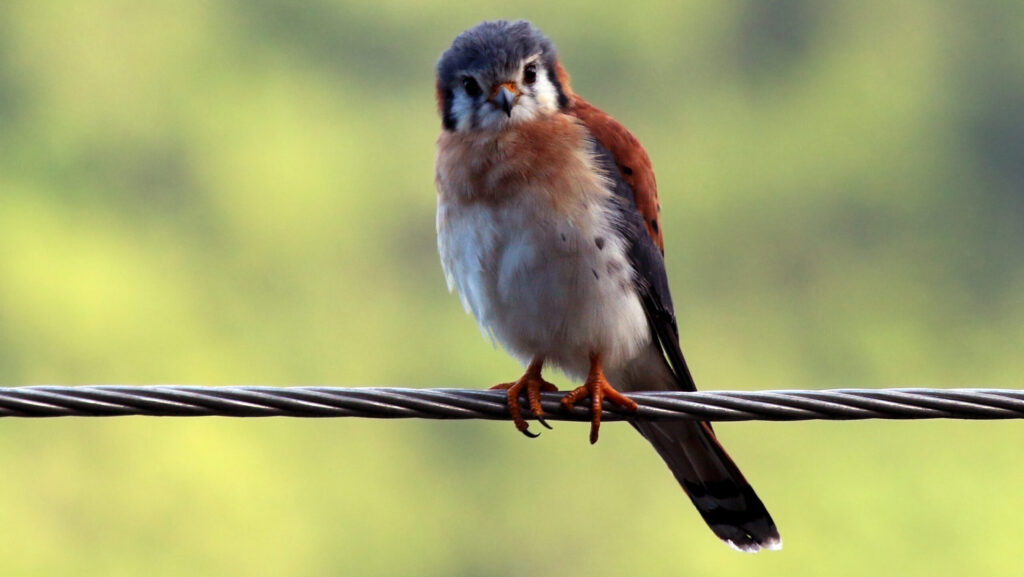
Power lines and telephone wires offer birds ideal perching locations for several practical reasons. First, these elevated perches provide excellent vantage points to spot both potential predators and prey, giving birds a significant survival advantage. Second, the height of wires keeps birds safely away from ground-based threats like cats, foxes, and other predators. Third, the smooth, round surface of wires is actually well-suited to birds’ feet, which have evolved to wrap around and grip branches—a design that works equally well on man-made cylinders. Finally, wires are abundant in human-populated areas, offering convenient resting spots in environments where natural perches may be limited due to development and deforestation.
The Science of Bird Feet and Wire Perching

Birds possess a remarkable anatomical feature that makes wire-perching possible: the tendon locking mechanism. This specialized adaptation automatically tightens a bird’s grip when it lands on a perch, allowing birds to hold securely onto wires without exerting constant muscular effort. The arrangement of toes—typically three forward and one backward in perching birds—creates a perfect wrapping configuration for cylindrical objects like wires. Most remarkably, birds can even sleep on wires without falling because their feet remain locked in position. This efficient design explains why birds can remain comfortably perched for extended periods, whether resting, preening, or socializing with neighboring birds.
Social Dynamics: Birds of a Feather Flock Together
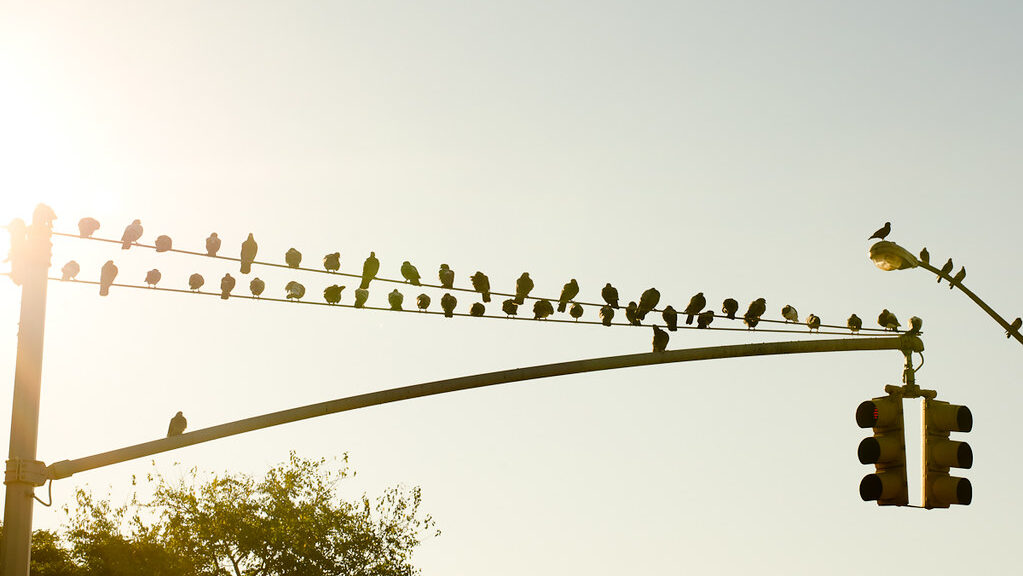
The species composition of birds on wires reflects fascinating social dynamics in the avian world. Birds typically line up with members of their own species, demonstrating the principle of “birds of a feather flock together” in literal form. This grouping behavior provides multiple benefits, including enhanced protection from predators through increased vigilance. Social species like starlings and swallows often form large, species-specific groups, while more solitary birds might maintain distance from others even when sharing the same wire. Researchers have observed that these wire formations often mirror the natural flocking behaviors seen in each species’ native habitats, suggesting that wire-sitting is an adaptation of innate social patterns to modern infrastructure.
Safety in Numbers: Predator Protection Strategies
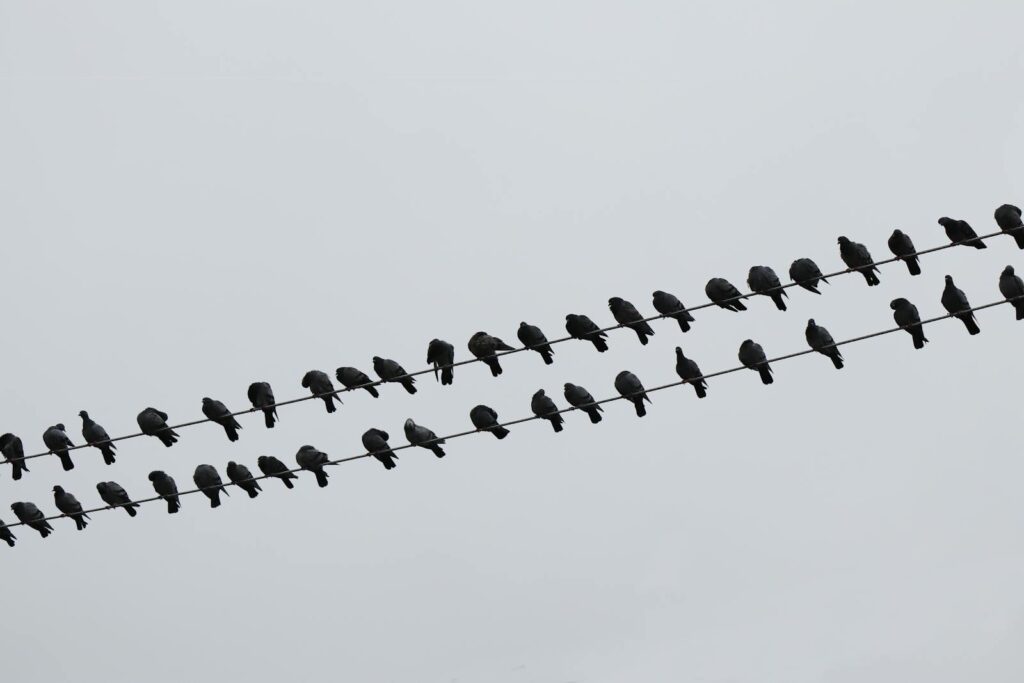
The linear arrangement of birds on wires serves as an effective predator defense mechanism. When birds gather in groups, they benefit from collective vigilance—more eyes scanning for potential threats means greater overall safety for the group. If one bird spots a predator and takes flight, others typically follow immediately, creating a ripple effect of alertness. Some species maintain specific distances between individuals, allowing enough space for quick escape while still remaining part of the protective group. Interestingly, scientists have noted that birds often position themselves strategically along wires, with more vulnerable individuals taking central positions where they’re surrounded by others who can serve as early warning systems.
Weather Protection: Huddling Behaviors
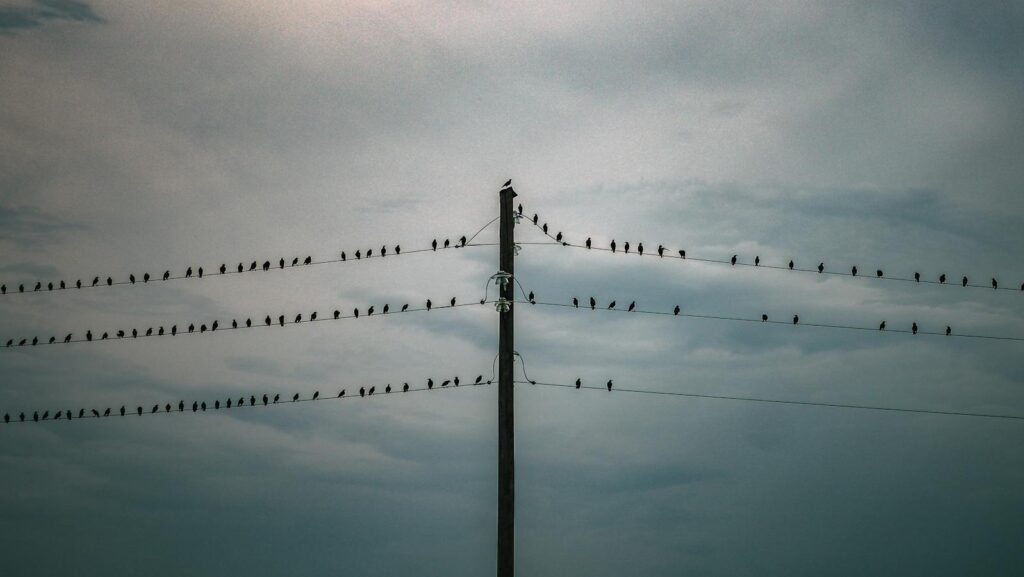
During adverse weather conditions, birds on wires often adjust their spacing and positioning for protection. In cold weather, many species will huddle closer together to share body heat, sometimes even fluffing their feathers to create additional insulation. When facing strong winds, birds typically position themselves facing into the wind to prevent their feathers from being ruffled, which would reduce their insulating properties. During rainfall, birds may tuck their heads under their wings while maintaining their perch on the wire. The wire itself provides an advantage during wet weather by keeping birds elevated above waterlogged ground where hypothermia would pose a greater risk.
Migration Staging: Gathering Before the Journey

Power lines often serve as important gathering points for migratory species preparing for long journeys. These wire gatherings can reach impressive numbers during migration seasons as birds congregate before departing together. Species like swallows and starlings may use wire gatherings as staging areas where they build up necessary energy reserves and synchronize their departure timing. Young birds may learn migration routes and timing by observing older, experienced individuals during these pre-migration assemblies. Researchers sometimes monitor these wire gatherings to track migration patterns and population health of various bird species across seasons.
Morning and Evening Rituals: Daily Patterns
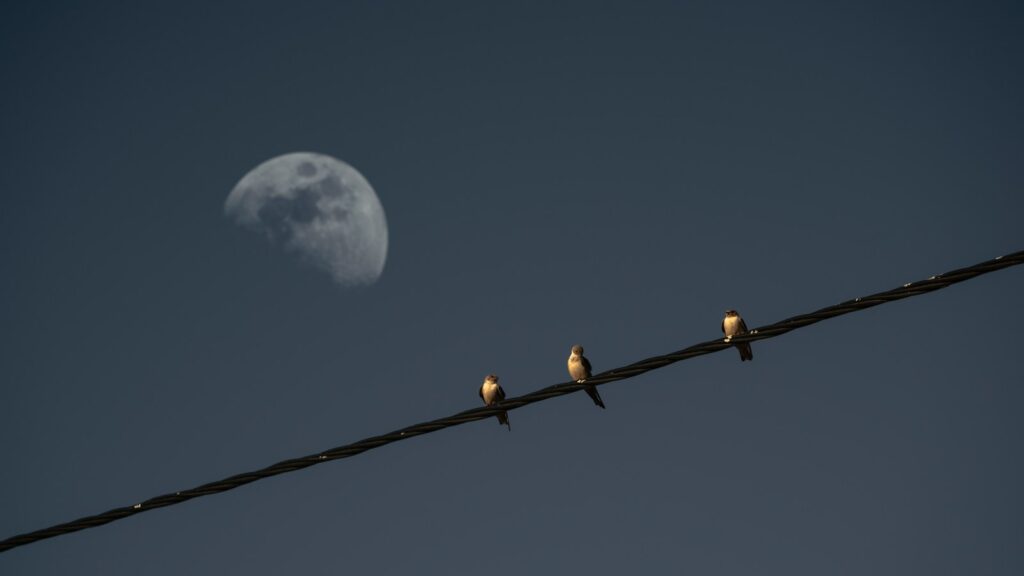
Bird presence on wires often follows predictable daily patterns that reflect their natural rhythms and behaviors. Dawn typically brings increased wire activity as birds prepare for daytime foraging, using the perches to survey feeding areas and plan their day. Throughout daylight hours, wire occupation may fluctuate as birds alternate between feeding expeditions and rest periods. The most dramatic wire gatherings often occur during evening hours as diurnal species return to safe perching locations before nightfall. These dusk gatherings frequently involve social interactions, preening, and communication that seem to serve community-building functions among gregarious species.
Species-Specific Behaviors on Wires
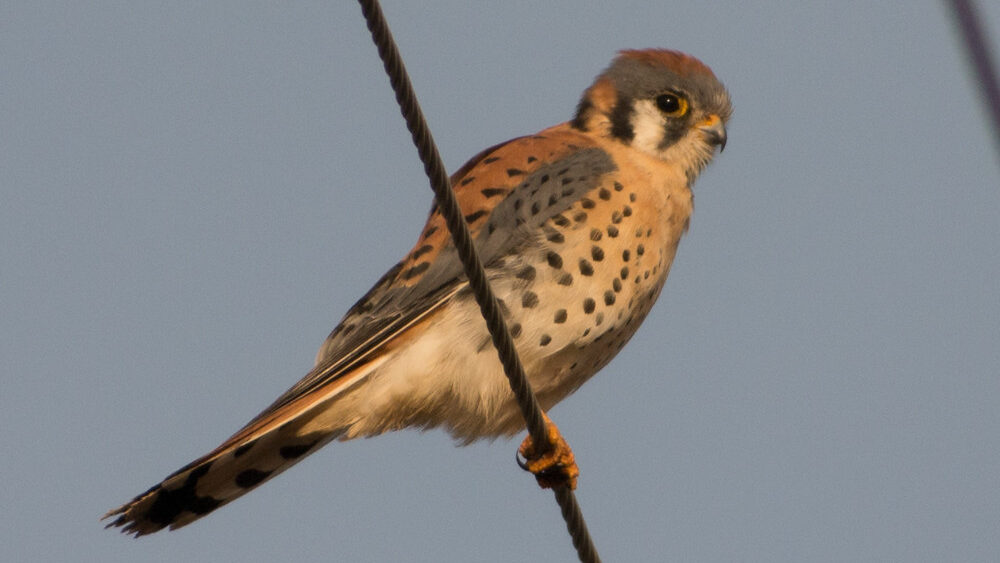
Different bird species exhibit characteristic behaviors when perched on wires, reflecting their unique ecological niches. Swallows and swifts, aerial insect hunters, use wires as launch pads for feeding flights, repeatedly taking off to catch insects before returning to their perch. Birds of prey like kestrels may use isolated wire perches as hunting platforms, scanning open areas for small mammals or insects below. Mockingbirds and other territorial songbirds often select prominent wire positions from which to broadcast their songs, maximizing the reach of their vocal displays. Pigeons and doves, highly social species, typically gather in tight-knit groups on wires, maintaining physical proximity that reflects their communal nature.
Wire Spacing: The Mystery of Bird Distances
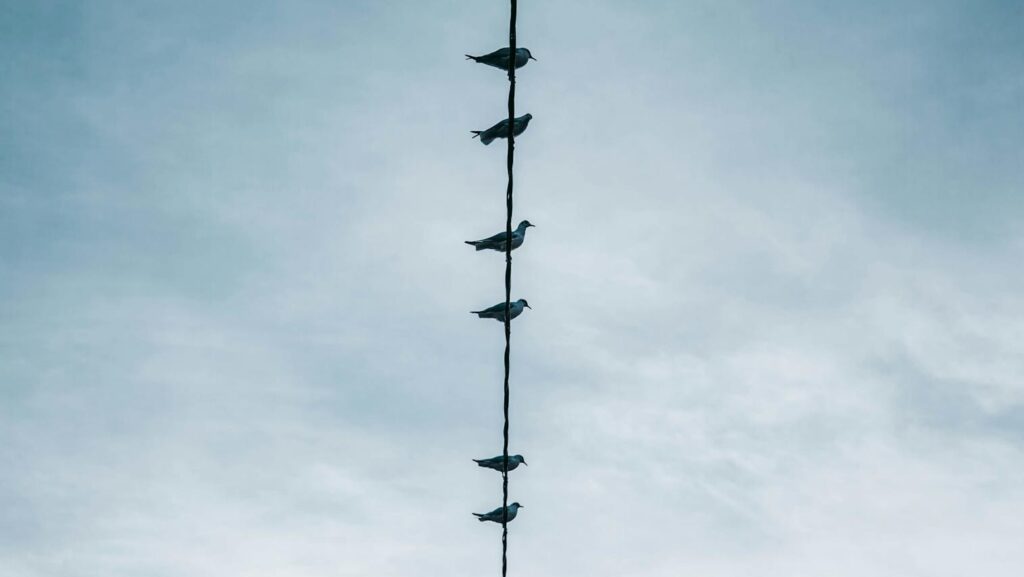
The precise spacing between birds on a wire has fascinated ornithologists and casual observers alike, as it often appears remarkably uniform. This spacing behavior stems from a balance between social attraction and individual space requirements that varies by species. Some birds maintain minimum distances to ensure quick escape routes if threatened, avoiding collisions with neighbors during sudden takeoffs. In many species, this spacing correlates with the bird’s physical size—larger birds typically maintain greater distances than smaller ones. Researchers have observed that spacing often corresponds to each species’ natural “personal space” requirements, suggesting that even in artificial environments, birds follow innate behavioral patterns developed over evolutionary time.
Communication Along the Line

Wires serve as effective communication platforms where birds exchange vital information through various signals. Visual communication occurs as birds observe their neighbors’ reactions to potential threats or food sources, creating information networks that benefit the entire group. Vocal communication happens continuously along wire gatherings, with alarm calls spreading rapidly when danger is detected. Some species engage in coordinated behaviors while perched, such as synchronized preening or movement that strengthens social bonds. The linear arrangement on wires actually facilitates communication by providing clear lines of sight between individuals, making these artificial perches surprisingly effective for avian social networking.
Dangers of Wire Perching

Despite their popularity as perches, power lines and other wires pose significant hazards to birds under certain circumstances. Electrocution can occur when large birds touch two wires simultaneously or when a bird contacts both a wire and a grounded component, creating a complete circuit. Collisions with wires represent another major threat, particularly for fast-flying species or during low-visibility conditions such as fog or darkness. Some birds may become entangled in damaged wires or associated materials like frayed insulation. Conservation organizations work with utility companies to implement bird-friendly designs that include insulation covers for dangerous connection points and visual markers that make wires more visible to flying birds.
Cultural Significance and Human Perception
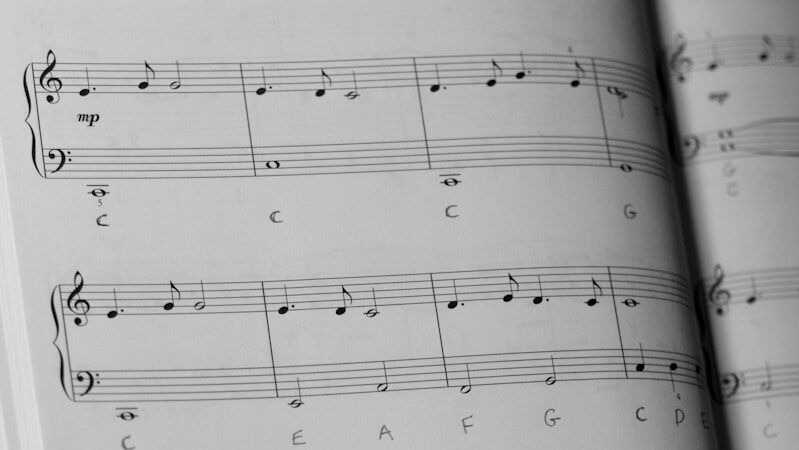
Birds aligned on wires have become an iconic image that resonates throughout human culture and artistic expression. This visual motif appears frequently in photography, often symbolizing concepts like conformity, community, or the boundary between natural and human-made worlds. Musicians have found inspiration in this image, most famously in composer Jarbas Agnelli’s piece “Birds on the Wires,” which transformed a photograph of birds on wires into musical notation. In literature and poetry, lined-up birds often serve as metaphors for human social behavior or as symbols of freedom within constructed environments. The universal recognition of this image demonstrates how deeply bird behaviors have permeated human consciousness, even in modern urban settings where our connection to wildlife might otherwise be limited.
Observing and Identifying Wire-Perching Species

Wire-watching offers an accessible entry point into bird observation for beginner birdwatchers and citizen scientists. Common wire-perching species in North America include American robins, mourning doves, European starlings, and various swallow species, each identifiable by distinctive silhouettes, sizes, and behaviors. Experienced birdwatchers learn to recognize species even from a distance by observing characteristics like tail length, body shape, and perching posture. Seasonal changes in wire gatherings provide insights into migration patterns and population trends that contribute valuable data to ornithological research. Many bird identification apps and websites now include specific guidance for identifying birds on wires, acknowledging this as a common context in which people encounter and become curious about avian life.
Conclusion

Birds lined up on wires represent a fascinating intersection of natural behavior and human infrastructure. What might appear as simply a convenient resting spot reveals complex social dynamics, survival strategies, and adaptations to our modern landscape. The next time you notice a row of birds perched along a wire, take a moment to appreciate the intricate behaviors unfolding before you—the careful spacing, the species groupings, and the constant vigilance. These aerial gatherings demonstrate nature’s remarkable ability to adapt to human-altered environments while maintaining the essential behaviors that have ensured avian survival for millions of years. In the ordinary sight of birds on a wire, we witness an extraordinary example of wildlife thriving alongside humanity.
